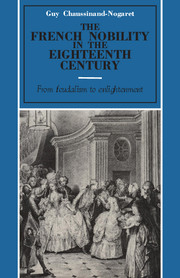Book contents
- Frontmatter
- Contents
- Introduction: the gilded ghetto of royal nobility
- 1 The Enlightenment and noble ideology
- 2 The nobility between myth and history
- 3 Plutocrats and paupers
- 4 The fundamental divide: culture
- 5 The nobility and capitalism
- 6 Rites and strategies: the marriage market
- 7 The nobility against the Old Regime
- 8 A plan for society
- Conclusion
- Afterword to the English edition
- Notes
- Bibliography
- Supplementary bibliography
- Index
2 - The nobility between myth and history
Published online by Cambridge University Press: 05 June 2012
- Frontmatter
- Contents
- Introduction: the gilded ghetto of royal nobility
- 1 The Enlightenment and noble ideology
- 2 The nobility between myth and history
- 3 Plutocrats and paupers
- 4 The fundamental divide: culture
- 5 The nobility and capitalism
- 6 Rites and strategies: the marriage market
- 7 The nobility against the Old Regime
- 8 A plan for society
- Conclusion
- Afterword to the English edition
- Notes
- Bibliography
- Supplementary bibliography
- Index
Summary
It matters little in itself whether there were 100,000 nobles or 500,000. Like every elite, the old regime nobility defined itself not so much by volume as by weight, by structure rather than by numerical strength. What mattered was its social density. If its influence, its role in the state and its weight in public life had been reduced to the exact level and proportion of its numbers, it would have been nothing in a Nation of 26 millions. But an elite is measured by its dynamism; its existence is linked to the image made of it by the society which secretes and encapsulates it. It is rooted in the magic of social symbolism, as something worth competing for, and/or imitating. Part of its survival depends on the aspiration or the capacity of outsiders to copy and/or challenge it, to admire and/or oppose it, to join and/or supplant it; and part depends on the credibility of its chosen image. This needs to be all the more sound when, as in the case of the old regime nobility, the elite is better defined, its frontiers more rigorous, and the barrier separating it from outsiders institutionalised and juridically defined. In this case it must match a more-or-less imaginary model based on myth.
Thus the nobility's existence was rooted in two concepts both objective and mythic: race and history, twin mirrors in which all nobility was reflected, two poles in which the distinctive worthiness of the elite was invested.
- Type
- Chapter
- Information
- The French Nobility in the Eighteenth CenturyFrom Feudalism to Enlightenment, pp. 23 - 42Publisher: Cambridge University PressPrint publication year: 1985



